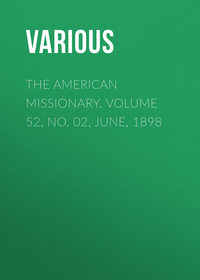![Birds and Nature Vol. 9 No. 1 [January 1901]](/covers_330/25569143.jpg) полная версия
полная версияBirds and Nature Vol. 9 No. 1 [January 1901]
As a rule its note, which is a sharp, shrill cry, is only sounded when flying.
As a nesting site, hollow trees are more frequently chosen. However, nests built of twigs and lined with grass are not infrequent. These are usually placed on the tops of stumps or among the branches of dense cone-bearing trees. The number of eggs varies from three to seven, and are frequently laid long before the ice and snow have disappeared. “The eggs vary from oval to oblong oval in shape, are pure white in color, and somewhat glossy, the shell is smooth and fine-grained.” Incubation begins as soon as the first egg is laid, and both sexes participate in this duty, and occasionally both are found on the nest at the same time. At the nesting season the courage of both sexes is very marked. The male will fight with its talons, and even when wounded will still defend itself. We are told by Mr. Gentry that “calmly and silently it maintains its ground, or springs from a short distance on its foe. So, bravely it dies, without thought of glory and without a chance of fame; for of its kind there are no cowards.”
This bird, like the other species of owls, though possibly not to so great an extent because of its diurnal habits, is looked upon by the Indian tribes as a bird of ill omen and by some tribes all owls are called “death birds.” As a whole, the hawk owls are perhaps more useful to man than any other birds that are not used as food. They cause but little trouble in the poultry yard and are of incalculable value to the farmer because of the large number of small rodents that they destroy.
A BIRD CALENDAR BY THE POETS
January.
This is not the month of singing birds.
“Silently overhead the hen-hawk sailsWith watchful, measuring eye, and for his quarry waits.”– Lowell.February.
Sometimes a flock of strange birds descends upon us from the north – the crossbills. There is an old tradition that the red upon their breast was caused by the blood of our Saviour, as they sought to free Him with their bills from the cross.
“And that bird is called the Crossbill,Covered all with blood so dear,In the groves of pine it singethSongs, like legends, strange to hear.”– Longfellow.March.
No birds are more closely associated with early spring than the swallows.
“Gallant and gay in their doublets grey,All at a flash like the darting of flame,Chattering Arabic, African, Indian —Certain of springtime, the swallows came.“Doublets of grey silk and surcoats of purple,Ruffs of russet round each little throat,Wearing such garb, they had crossed the waters,Mariners sailing with never a boat.”– Sir Edwin Arnold.April.
“Winged lute that we call a Bluebird,You blend in a silver strain,The sound of the laughing waters,The sound of spring’s sweet rain,“The voice of the wind, the sunshineAnd fragrance of blossoming things.Ah, you are a poem of AprilThat God endowed with wings.”May.
This is the month of the Bobolinks.
“Merrily, merrily, there they hie;Now they rise and now they fly;They cross and turn and in and out,And down the middle and wheel about,With ‘Phew, shew, Wadolincoln; listen to me Bobolincoln!’Happy’s the wooing that’s speedily doing,That’s merry and over with bloom of the clover,Bobolincoln, Wadolincoln, Winterseebee, follow me.”June.
“Then sings the Robin, he who wearsA sunset memory on his breast,Pouring his vesper hymns and prayersTo the red shrine of the West.”July.
The full tide of song is on the ebb, but you still hear in the shadowy woods the silvery notes of —
“The wise Thrush, who sings his song twice over,Lest you should think he never could recaptureThat first fine careless rapture.”– Browning.August.
The humming-bird.
“When the mild gold stars flower out,As the summer gloaming goes,A dim shape quivers aboutSome sweet rich heart of a rose.“Then you, by thoughts of it stirred,Still dreamily question them,‘Is it a gem, half bird,Or is it a bird, half gem?’”– Edgar Fawcett.September.
There is something wistful in the notes of the birds preparing to depart. In the woods we see —
“A little bird in suitOf sombre olive, soft and brown,With greenish gold its vest is fringed,Its tiny cap is ebon-tinged,With ivory pale its wings are barred,And its dark eyes are tender starred.‘Dear bird,’ I said, ‘what is thy name?’And thrice the mournful answer came,So faint and far and yet so near —‘Pewee! Pewee! Pewee!’”– Trowbridge.October.
This brown month surely belongs to the sparrows.
“Close beside my garden gateHops the sparrow, light, sedate.”* * * “There he seems to peek and peer,And to twitter, too, and tiltThe bare branches in betweenWith a fond, familiar mien.”– Lathrop.November.
In cold weather the little gray Chickadee cheers us with his “tiny voice” —
“Gay and polite, a cheerful cry,Chick-chickadedee! Saucy note,Out of sound heart and merry throat!This scrap of valor, just for play,Fronts the north wind with waistcoat gray.”– Emerson.December.
The sleep of the earth has begun under the white, thick snow. The Owl is abroad by night —
“A flitting shape of fluffy downIn the shadow of the woods,‘Tu-wit! tu-whoo!’ I wish I knew;Tell me the riddle, I beg —Whether the egg was before the OwlOr the Owl before the egg?”Arranged by Ella F. Mosby.So when the night falls and the dogs do howl,Sing ho! for the reign of the horned owl.We know not alwayWho are kings by day,But the king of the night is the bold brown owl.– Barry Cornwall.THE OYSTER AND ITS RELATIVES
Of all the grand divisions of the Animal Kingdom, the subkingdom Mollusca is probably the least known to the ordinary observer, and if one were asked to enumerate as many different kinds of “shell fish” as he could, it is probable that not over six or eight different varieties would be named. The majority of people think of a clam, oyster, mussel, snail or Nautilus and their molluscan vocabulary ends with these names. And yet this group of animals is second only to the insects in number of different species, beauty of coloration and interest of habitat. They may be found everywhere, in salt and fresh water, in our forests and fields, our ponds, brooks and rivers; in the valleys and on the mountain tops, and even in the waters of the frozen north, while in the warm waters of the tropics they flourish in uncounted millions. In size they range from the little sea-snails hidden in the eel grass along the shore, with tiny shells scarcely an eighth of an inch in length, to the giant squid, which measures forty feet or more from the tip of its tail to the end of its long arms; and they range from the tide-washed beach to the abyssal depths of the ocean. It is to these lowly creatures that I would draw the reader’s attention.
In nearly all the species of the Mollusca the animal is protected by a hard shell, made of carbonate of lime, which is covered with a horny epidermis to protect the limy shell from being dissolved by the acids in the water. This shell is generally capable of containing the entire animal, thus affording, in most cases, adequate protection for the soft body. Those animals not provided with a shell, as is the case with the land slugs, are capable of covering themselves with a sort of mucus which encysts and protects them from both extreme heat and cold.
The lowest branch of Mollusca is known as class Pelecypoda, which comprises all of the different kinds of clams, mussels, quahaugs, etc., in which the body is protected by two hard, calcareous shells placed, generally, opposite each other and connected on the upper margin by a ligament, and the two valves work back and forth in teeth and sockets, making a kind of hinge. A set of stout adductor muscles keep the two shells or valves together and allow them to open and close at the will of the animal. The majority of clams live in the mud in a horizontal position, the anterior end being buried and the posterior end, containing the siphons which draw in and expel the water, being out of the mud, in the water. The clam progresses by pushing forward its strong, muscular foot, getting a firm hold of the mud and then drawing the shell after it. Some pelecypods, as the oyster, live attached to some object on the bottom of the water, as a stone, piece of wood or piling of an old wharf, and are not able to travel from place to place as are the true clams, examples of the latter being fresh water mussels and the marine quahaug or round clam.
Some bivalves also attach themselves by a byssus composed of a number of silk-like threads, which anchor their shells to stones, sticks, and other foreign objects. In one group (genus Pinna) found in the Mediterranean Sea, this byssus is so fine and silky that the Italians weave it with silk and make caps, gloves and other articles of wearing apparel.
Another wonderful and interesting arrangement for the comfort of the animal is its breathing organs or branchiae. These are two or four in number, and are made up of numerous small chambers, covered with little whip-like organs or cilia, which keep up a constant motion, creating currents of water, bring thousands of minute organisms to the clam to serve as food. These little organisms, many of them microscopic, are caught upon the surfaces of the gills, rolled into little masses, and passed into the animal’s mouth. Besides being food-gatherers, the gills serve to keep up a circulation by which fresh water is constantly brought in to purify and aerate the blood and also to expel the waste products. There is no head in this class, and the mouth is an oval slit surrounded by four lips or palpi, and leads almost directly into the stomach.
The currents of water spoken of above are controlled and directed in several different ways. In attached forms, and those living above the surface of the mud, like the oyster, mussel and scallop, the soft mantle which lines the shell is divided, forming a slit nearly the whole diameter of the shell, and the water is allowed to circulate freely through the open edges of the shells. But in those animals which burrow in the mud, as the common little neck clam, fresh water clam and quahaug, this mantle is closed and prolonged posteriorly into one double or two single siphons or tubes, one being fringed with little finger-like cilia and drawing in the water by their motion, and the other expelling the water after it has circulated through the animal.
One of the most attractive families of bivalve shells is the Veneridae, or venus shells, in which the shelly skeleton is ornamented by many bright colors, the patterns occurring in spots, dashes, zigzag lines and rays. Some varieties, as the spiny venus (Cytheria lupinaria) have the posterior end of the shell provided with long, sharp, curved spines, and the shell is also frilled in a beautiful manner. The common quahaug (round or hard-shelled clam), which is esteemed an article of diet on the Atlantic coast, and also to some extent in the interior, is a prominent member of this family. The Veneridae comprise some five hundred species, found throughout the world, and ranging from the shore between tides to several hundred fathoms in depth.
The family Cardiidae, the heart-shells or cockles, comprise some of the largest and most attractive of mollusks. The name Cardium, signifying a heart, is given them because of the close resemblance to that organ when a shell is viewed from the anterior end. These animals live in sandy or muddy bays, and generally congregate by thousands. In England, the edible cockle (Cardium edule) is considered quite a delicacy and thousands are used for this purpose. In our own country they are not generally eaten, except by the poor in Florida and in some places along the Gulf of Mexico, but the waters of Florida furnish some very handsome species, among them the Cardium isocardia figured on our plate, and the large Cardium magnum, which grows to a length of five inches and whose shell is ornamented by beautiful color-patterns of brown and yellow. The foot of the Cardium is very peculiar, being shaped like a sickle, which enables the animal to pull itself along at a lively gait. A California cockle (Liocardium elatum) grows to a diameter of seven inches and would furnish a meal for several people.
In the family Tridacuidae size seems to have reached its limit. Tridacena gigas, found in the Indian Ocean, grows to a length of nearly six feet and weighs upwards of eight hundred pounds. Tryon records that a pair of these shells, weighing five hundred pounds, and two feet in diameter, are used as benetiers in the church of St. Sulpice, Paris. In some parts of the Indian Ocean, where pearl and sponge-fishing are carried on, this clam (known as the giant clam), is a source of great danger to the divers, many losing their lives by being caught between the great valves of the shell, by either hands or feet. Many times a diver has amputated his fingers, hand or foot, and thus saved his life at the expense of one or more of these members.
The Tellinas (family Tellinidae) number among its five hundred or more species some very beautiful and interesting animals. They live for the most part buried in sand or sandy mud and are found throughout the entire world. Our common Tellina radiata, familiarly called sunshell, is found in Florida and the West Indies, and a typical valve looks not unlike the horizon at sunrise, the brilliant rays of color spreading in different directions from a common center. At Newport, Rhode Island, the writer has gathered many thousand specimens of a beautiful little Tellen (Tellina tenera), whose shell measures scarcely half an inch in diameter and is tinted a lovely pink or pinkish white. The siphons of this family are very long and are separated, the upper one being half or three-quarters as long as the lower one, and the foot is rather long and pointed, admirably adapted for burrowing. The long siphons enable the animal to bury itself to quite a depth beneath the surface of the sand.
Closely related to the Tellinidae is the Psammobiidae, a characteristic form of which (Psammobia rubroradiata) is thus spoken of by Prof. Josiah Keep, in his interesting little book, “West Coast Shells:” “But I wanted to see more of him, so I took a large jar, filled it half full of beach sand, added as much sea-water as it would hold, and plunged my prize into the same. He rested quietly for a few minutes, and then began to open his shell and cautiously put out his two siphons. Soon afterward, from between the edges of his shells, came his big, white, spade-shaped foot. He drove it down into the sand, curved it a little to one side, gave a vigorous pull, and lo! his shell followed, though just why I could not clearly understand. Though the jar was large he reached the bottom before his shell was wholly covered with sand, and had to content himself with a half-above-ground tenement.”
“Next morning his siphons were stretched out some six inches in length. * * * I never thought before that there was any particular beauty to the siphons of a clam, but for this red-lined one my opinions quickly changed. Imagine two tubes made of the finest pink and white silk, stretched over delicate hoops arranged at regular intervals; then think of them as endowed with life, and waving with a graceful motion through the water, and you will have a faint idea of their exquisite texture and elegant appearance.”
To those readers who live in the West, away from the ocean, the Unio, or freshwater mussel, is more or less familiar. What child in Chicago has not played on the sands of Lake Michigan and scooped up the little grains with the broken half of a clam shell? Or who, wading in the muddy water of Lake Calumet, has not wondered what the curious little hollow, fringed objects were which protruded from the surface of the mud? These latter were the siphons of the clam and if you were to dig under them a little way you would find the beautiful green-rayed shell of a river mussel. These are no less interesting than the marine shells already described and in beauty of ornamentation they frequently excel many of their salt-water relatives. Such excrescences as knobs, spines and rib-like undulations are common, while the colors of the interior range from pure silvery white through orange, pink and salmon to dark purple, and the rich, pearly iridescence rivals that of any of the marine shells. In many parts of the West mussels are collected by men in search of pearls, which are generally of an inferior quality, and thousands of shells are used annually in the manufacture of pearl buttons.
One of the most familiar objects to the seaside visitor is the huge banks of sea-mussels (Mytilus) which line the shore at low water. The shells are generally dark-colored, our common mussel (Mytilus edulis) being frequently jet black, and are more or less wedge-shaped in form. They attach themselves to mud banks and shore vegetation by a strong byssus made up of stout, more or less silky threads. The mussels are of great value economically, thousands of bushels of the edible mussel (Mytilus edulis) being consumed annually in Europe. They are also used as bait, and millions of the mussels are thus used every year. Although considered a delicacy in parts of Great Britain and Europe, it has not yet been adopted as an article of diet in this country, the clam and quahaug taking its place.
The family Aviculidae, comprising the wing-shells or pearl oysters, is of great interest, both scientifically and economically. At the present time there are a little over one hundred species living, but the family has been known from early geological times and over a thousand species have been found in the rocks. The pearl-oyster (Melleagrina margaritifera) is the most important member of this family, furnishing as it does the beautiful pearls of commerce. These animals are found at Madagascar, Ceylon and other parts of the Indian Ocean, several hundred tons being imported into Europe annually. These pearls are formed by some irritating substance, as a grain of sand or some parasite, getting in between the shell and the animal, or lodging in some soft part, which causes the animal to cover it with pearly matter to prevent irritation. The shells also furnish a considerable part of the “mother-o’-pearl” which is so largely used for ornamental purposes. The Margaritifera radiata, figured on our plate, is a member of this family.
The scallop is an object well known to the tourist visiting New England summer resorts, who has reveled in “fried scallops.” The family to which this belongs (Pectinidae) is composed of rounded shells, many with frills or ribs and nearly all ornamented with beautiful colors. Unlike the animals which we have been considering, these mollusks have no siphons and the shell is open all the way around save at the hinge, and the edge of the mantle is provided with little, round, black eyes. It is an interesting sight to observe a beach at low water, the receding tide having left on the shore or in little pools of water hundreds of these mollusks, attached by a byssus to bits of sea weed. As one is gazing wonderingly over this vast field of yellow sand and green weed, an object will suddenly move through a pool of water with astonishing rapidity, accompanying the movement by a quick snapping sound. This is the scallop, which is imprisoned in the pool and which desires to get out. The movement is effected by rapidly closing and opening the two valves of the shell, thereby causing a clicking sound. The noise of several hundred of these shells opening and closing and the sight of as many scallops with strings of sea weed attached to them, shooting through the water, looking not unlike a comet with a long tail, is quite bewildering. In Europe, the scallop is considered quite a delicacy and several tons are gathered annually. One species (Pecten jacobaeus) has been dignified as a badge of several orders of knighthood and it was also worn by pilgrims to the Holy Land a good many years ago. It was called “St. James’ Shell.”
The most common shell to the layman is the oyster (Ostrea virginica), the cultivation of which occupies the attention of a large number of men and the investment of considerable capital. The oyster is free and active when young, but becomes attached to some submerged object early in life. Oyster culturists take advantage of this habit by erecting poles in the water to which the young oysters attach themselves. The shells of the different species of oyster are not generally of much beauty, but a related family, the Spondylidae, or spiny oysters, are among the most beautiful of bivalves. In this family the shell is ornamented by many long spines and frills, and the colors are different shades of red, yellow and pink. The most beautiful species are found in the Gulf of California.
The space at our command is far too limited to adequately discuss the many curious and interesting animals which make up the class Pelecypoda. Much might be said of the Solen or razor-shell, with its curious foot which is so great a help in digging burrows; of the Pholads, which perforate and make burrows in clay, wood and even in the hardest rock; and of the strange Teredo or “shipworm,” with a long, worm-like body which bores into ships, wharves and any wooden object within reach. But enough has been written and pictured to show the reader that the unpretentious clam, mussel or oyster and their relatives have many interesting habits, are encased in beautiful shells, and that some species are of great economic importance to man.
Frank Collins Baker.THE PASSING OF SUMMER
Where have the charms of summer gone?Part of its sunny, azure skiesThe bluebirds southward bore away,And how could sunset splendors stay,Or glory of the early dawn,When not a tanager now viesWith orange-flaming orioles,And humming-birds no magic bowlsOf nectar drain in gardens fair,Or flash like jewels through the air?Where have the summer’s beauties flown?Afar on swallows’ purple wings;With blackbirds’ iridescent throats,And with the thrushes’ perfect notesOf rapture into music grown;With blue the indigo bunting brings,A sapphire set with emerald leaves,And finch-gold that June interweavesWith silver from the kingbird’s breastAnd studs with pearls of many a nest.When will the summer come again?When olive warblers northward fly,And to their hints of budding greenThe grosbeaks add a rosy sheenOf warming skies: O, not till thenWill summer come and winter die!– Benjamin Karr.THE COLLARED LIZARD
(Crotaphytus collaris.)
The Collared or Ring-necked Lizard may be found among the rocks and open woods of the plateau or in desert regions from southern Missouri southward into Mexico, westward to southeastern California and northward to southern Idaho. However, this is its general range, and it is not common over all this territory. Though it has been known to ascend to an altitude of nearly six thousand feet, yet it does not seem to have crossed the Sierra Nevada range, as it has not been observed at any point on the Pacific coast or the interior of California.
The Collared Lizard is so called because of the black bars, which resemble a collar, and are situated between the fore legs and extend across the back of the animal. They vary greatly in color, depending on their age or geographical position. The back is usually some shade of dull or rather dark green, or it may have a bluish cast, with numerous oblong or rounded lighter spots, which may be either whitish, or various shades of red, orange or yellow. These spots may be quite definite or they may form quite continuous bands. The variations in color are much more marked in the young.
Dr. Cope tells us that “it runs very swiftly, carrying the tail over its back. In its manners it is perhaps the most pugnacious of our lizards, opening its mouth when cornered, and biting savagely. Its sharp teeth can do no more than slightly cut the skin.”
Mr. Frank M. Woodruff relates the following interesting account of his experiences with this lizard: “I found the Collared Lizard at three points in Missouri – Vineland, DeSoto and Pilot Knob. They are restricted to the rocky glades, where they live with the scorpions and the rattlesnakes. The only place where I found them abundant was between Vineland and the old Kingston mines. During the hot summer months they make their appearance upon the broad slabs of rock, often quite a distance from their lairs. When disturbed they make a dash to escape and usually in the direction that leads to their accustomed crevice, even though the intruder is in its path. I have had them run almost across my feet in their frantic efforts to hide. They are a somewhat terrifying object as they run toward you. At this time they apparently assume a partly upright position, looking for all the world like a small edition of Mephistopheles. The negroes are mortally afraid of them. They call them ‘Glade Devils,’ and the more superstitious believe that the souls of the very bad negroes reside in them. A negro will never go through a glade frequented by this species, and will make a long detour to avoid doing so. The only time I ever saw a negro ‘turn gray’ was when I brought one of these lizards to Ironton and asked for assistance in capturing it when it escaped. They are so swift in their movements that I found the best method of capturing them was by tying a noose of fine copper wire to a fish pole. This can be slipped over their heads, as they lie sunning themselves, as they seem to pay but little attention to the loop as it touches them. By exercising caution it is possible to approach from the rear to within eight or ten feet without exciting them. They make delightful pets, if a lizard can be considered such. By feeding them through the winter on meal worms and in the summer on flies and grasshoppers they can be kept for a year or more.”









